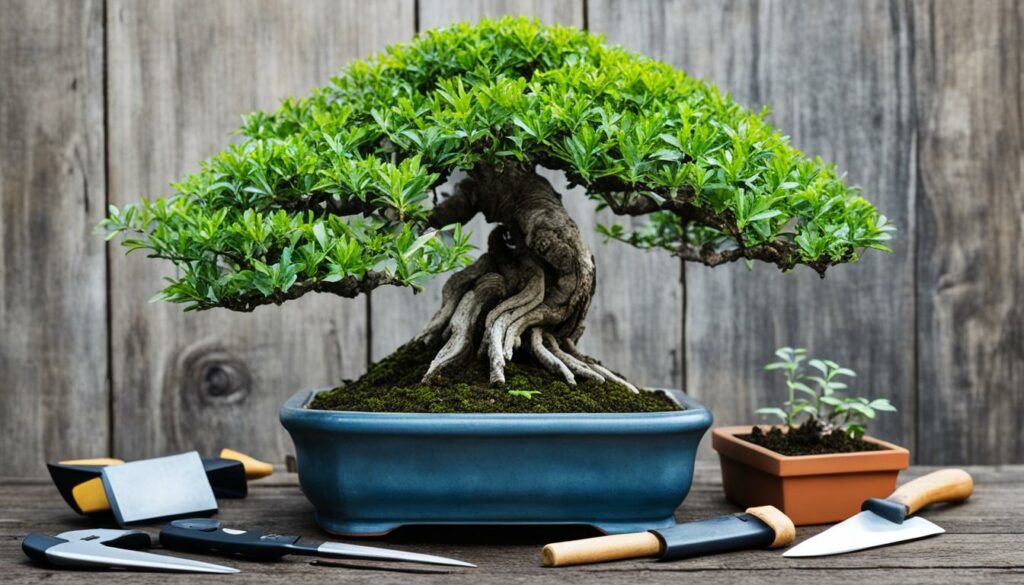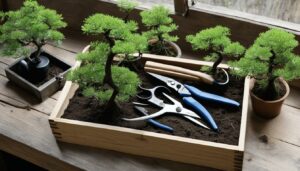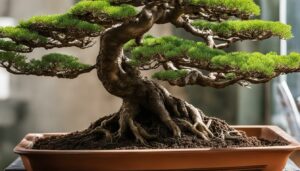Caring for a bonsai is an art form that requires patience, precision, and a deep understanding of your plant’s needs. If you’re among those who have encountered common bonsai care mistakes, you know how crucial problem-solving in bonsai cultivation is to the survival and beauty of your miniature tree. But fear not! Every challenge presents an opportunity to enhance your bonsai’s vitality and leaves you better equipped for maintaining plant health in bonsai. From overwatering woes to nutrient deficiencies, this guide is your ally, laying out the path to not only corrective measures but also preventive prowess.
As you embark on this journey of cultivation mastery, remember, the most exquisite bonsai trees have not only been nurtured with diligence but also with knowledge. Your commitment to learning and adapting is what will transform your bonsai practice from simply growing a plant to fostering a living sculpture.
Key Takeaways
- Learn to identify and correct common bonsai care mistakes for better plant health.
- Develop effective problem-solving techniques for bonsai cultivation challenges.
- Gain insights into preventative measures to keep your bonsai thriving.
- Master the art of providing tailored care to your specific bonsai species.
- Embrace continuous education and patience as you refine your bonsai nurturing skills.
Understanding Your Bonsai’s Unique Needs
Welcome to a deeper understanding of your bonsai’s unique needs. Recognizing that each bonsai species comes with its own set of specific requirements is the cornerstone of successful bonsai cultivation. This exploration digs into the bonsai care fundamentals that will guide you through the essential elements of light, water, temperature, and soil. It’s important to tailor your care practices to meet the bonsai species-specific requirements, ensuring your tree flourishes in its optimal bonsai growing conditions.
One common thread among all bonsai species is the need for a delicate balance of care. Too much or too little of any critical factor can lead to unwelcome issues. So, let’s break down these elements:
- Light: Bonsais require an adequate amount of light, usually a few hours of direct sunlight per day. However, the intensity and duration will vary based on the species. Some may prefer the soft morning sunlight with shaded afternoons, while others thrive with more prolonged exposure to sunlight.
- Water: Watering needs can differ drastically from one bonsai to another. While some prefer consistent moisture, other types may require a drying-out period between waterings. Understanding the watering requirements is crucial to prevent both dehydration and root rot.
- Temperature: Similarly, temperature preferences can range widely with bonsai trees. Tropical species may need warmth throughout the year, whereas temperate species experience a period of dormancy in colder weather.
- Soil: The right type of soil mixes affects drainage, aeration, and nutrients. Each bonsai species may need a particular balance to support its root system adequately. Whether it’s a well-draining gritty mix or a soil that retains more moisture, make sure it suits your bonsai’s needs.
By now, you should clearly understand why a one-size-fits-all approach to bonsai care simply does not work. Each species demands its special regimen, and it’s up to you to become attuned to these subtleties. Apply these insights to avoid common pitfalls and to foster a resilient and stunning bonsai that brings joy for years to come.
In summary, while bonsais may seem like a delicate collection of plants with uniform needs, in actuality, they represent a diverse group, each with distinct demands. Embrace the uniqueness of your bonsai and provide the patient, specialized attention it deserves. With the right knowledge and techniques, you can unlock the full potential of your bonsai and enjoy the serene beauty it adds to your space.
Recognizing Signs of Unhealthy Bonsai
As a dedicated bonsai enthusiast, being able to diagnose bonsai issues is essential to the health and longevity of your tree. Keep an eye out for symptoms of distress that may indicate your bonsai needs attention. By interpreting these symptoms early, you can take corrective action to nurse your beloved tree back to health. Let’s delve into the common problems bonsai plants face and uncover their underlying causes.
Yellowing Leaves and What They Mean
Bonsai leaf discoloration causes are various and often indicate nutritional deficiencies or environmental stress. Yellowing leaves, a common issue, can suggest a range of problems from overwatering to inadequate sunlight. Identifying the exact cause is key to restoring the vibrant green hues of your bonsai’s foliage.
Stunted Growth and Potential Causes
If you notice unusually slow or stunted growth in your bonsai, this could signal insufficient nutrients, pest infestations, or unsuitable growing conditions. Consistent monitoring and adjusting your care regimen are imperative to fostering robust growth.
Bark or Trunk Problems Indicators
Issues with your bonsai’s bark or trunk should not go unnoticed as they serve as the backbone of your tree’s health and structural integrity. Problems in this area might include cracking, rot, or unusual markings, each symptom requiring a unique approach to address effectively.
| Symptom | Possible Cause | Action to Take |
|---|---|---|
| Yellowing Leaves | Overwatering, Lack of Fertilizer, Poor Light | Adjust irrigation, Fertilize adequately, Relocate to well-lit area |
| Stunted Growth | Compacted Soil, Root Bound, Insects | Aerate soil, Repot bonsai, Apply appropriate pest control |
| Cracked Bark | Physical Damage, Extreme Temperatures | Protect from harm, Moderation in temperatures |
| Soft or Rotting Trunk | Fungal Infection, Excessive Moisture | Apply fungicide, Ensure good drainage |
By learning to recognize these signs of stress and understanding the possible causes of these issues, you’ll be better equipped to provide specialized care that benefits the unique needs of your bonsai.
Watering Techniques for Optimal Bonsai Care
Understanding the nuances of watering can mean the difference between a thriving bonsai and one suffering from hydration-related stress. In this section, we cover the salient points of proper bonsai watering practices to help you strike the right moisture balance and mitigate the risks of preventable issues.
Identifying Overwatering Symptoms
Overwatering is a common pitfall that can lead to detrimental results for your bonsai. Typical indicators include yellowing leaves, a spongy or soft trunk, and the presence of mold or algae on the soil surface. To prevent these symptoms of excess hydration, it’s crucial to understand your bonsai’s unique watering needs and to check for adequate drainage.
Correcting Underwatering Mistakes
On the flip side, underwatering can result in dry, brittle leaves and stunted growth. If you notice that your bonsai’s leaves are wilting or the soil is consistently dry, it’s time to revise your watering approach. Proper hydration is key to maintaining a healthy bonsai, so make sure to water thoroughly, allowing moisture to reach the entire root system.
Choosing the Right Watering Schedule
Finding the ideal watering schedule balances various factors, including your bonsai species, pot size, and the current season. As a guideline:
Water your bonsai when the top layer of soil feels slightly dry but not completely desiccated.
By tuning into the needs of your bonsai and observing the condition of the soil, you can create a personalized watering routine that maintains optimal bonsai hydration balance and prevents watering-related issues.
Remember, each bonsai is unique, and their requirements can alter with changes in the environment. Regular observation and adjustments to your watering practices will ensure the well-being of your bonsai for years to come.
Ensuring Adequate Sunlight for Your Bonsai
Understanding the bonsai light requirements is crucial for nurturing a vibrant and healthy tree. Each bonsai species has its unique necessities when it comes to sunlight exposure, which profoundly impacts plant health. The goal is to provide optimal light conditions for bonsai to flourish while steering clear of any negative ramifications of excessive direct sunlight.
Most bonsai thrive in bright, indirect light. Direct morning sunlight is gentle and can be beneficial, especially for species that originate from sunnier climates. However, harsh afternoon sunlight needs to be moderated. Effective light management ensures that your bonsai receives enough energy for photosynthesis without suffering from leaf scorch or excessive drying.
- Position your bonsai in a spot where it can bask in the morning sunlight but is shaded during the peak intensity of the afternoon sun.
- Consider the use of sheer curtains to diffuse the light when placing your bonsai near south-facing windows.
- Rotate your bonsai periodically to ensure all sides of the plant receive an equal amount of light, promoting balanced growth.
For those living in less sunny areas or during winter months, artificial grow lights may become a necessity. These lights can supplement the lack of natural sunlight and help maintain the necessary light levels your bonsai needs to stay healthy and grow.
Effects of sunlight on plant health are not just seen in growth, but in the bonsai’s ability to resist pests and diseases. A well-lit bonsai is typically more vigorous and can fend off issues more efficiently than a bonsai struggling for light.
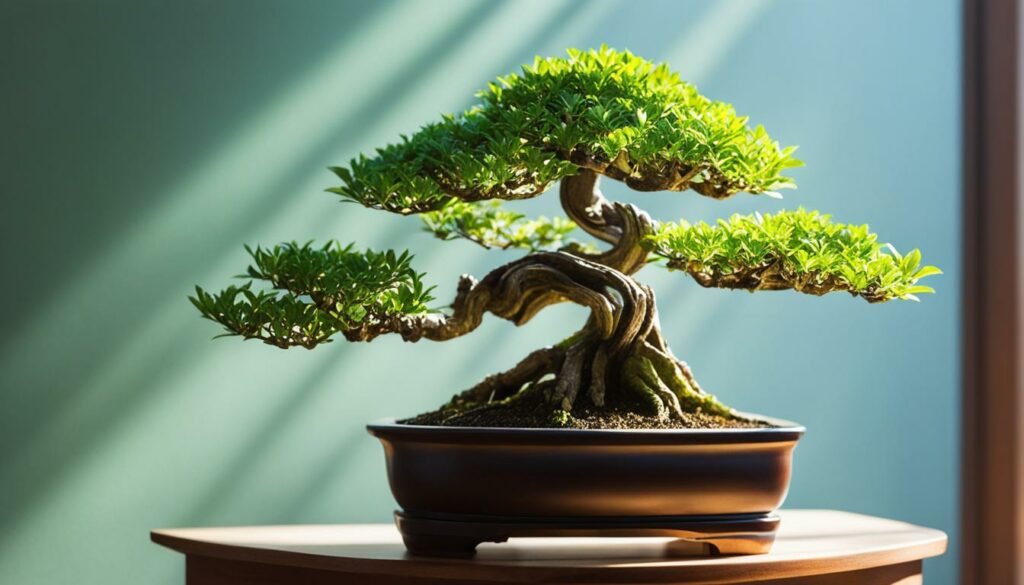
In summary, always aim for a balance when exposing your bonsai to sunlight. Remember that the quality and amount of light directly influence your bonsai’s well-being and that you might need to adjust its position with the changing seasons to maintain the optimal light conditions for bonsai health.
Feeding Your Bonsai: Fertilization Essentials
Proper fertilization is key to sustaining a healthy and vibrant bonsai. Understanding the specific nutritional requirements of your bonsai will help you in selecting bonsai fertilizers that are conducive to its growth and wellbeing. Mastering bonsai fertilization techniques ensures that your treasured plant receives all the essential nutrients without being subjected to toxic excess.
Understanding Fertilizer Types and Uses
There are various fertilizers available, each with its unique composition suited for different bonsai needs. Organic fertilizers gradually release nutrients and are less likely to cause harm due to nutrient excess, whereas chemical fertilizers are concentrated and require careful application to avoid damaging your bonsai.
Seasonal Fertilization Strategies
Bonsai trees have different nutritional demands depending on the season. During the growth period in spring and summer, a nitrogen-rich fertilizer can promote foliage development. In contrast, autumn requires a formula low in nitrogen but higher in potassium and phosphorous to strengthen the bonsai for winter.
Signs of Overfertilization and Remedies
Addressing nutrient excess in bonsai is crucial, as overfertilization can lead to salt build-up in the soil, causing root burn and leaf drop. Symptoms like discoloration or wilting signal that immediate intervention is needed. Flushing the soil with clean water can help mitigate the effects of overfertilization and rebalance the soil’s nutrient levels.
Troubleshooting Bonsai Issues with Pruning
Pruning is an integral component of bonsai pruning for health. When you encounter problems with your bonsai’s growth or shape, problem-solving through pruning offers a path to recovery. The precise bonsai trimming techniques outlined here can not only enhance the aesthetic appeal of your bonsai but also play a crucial role in its vitality and longevity.
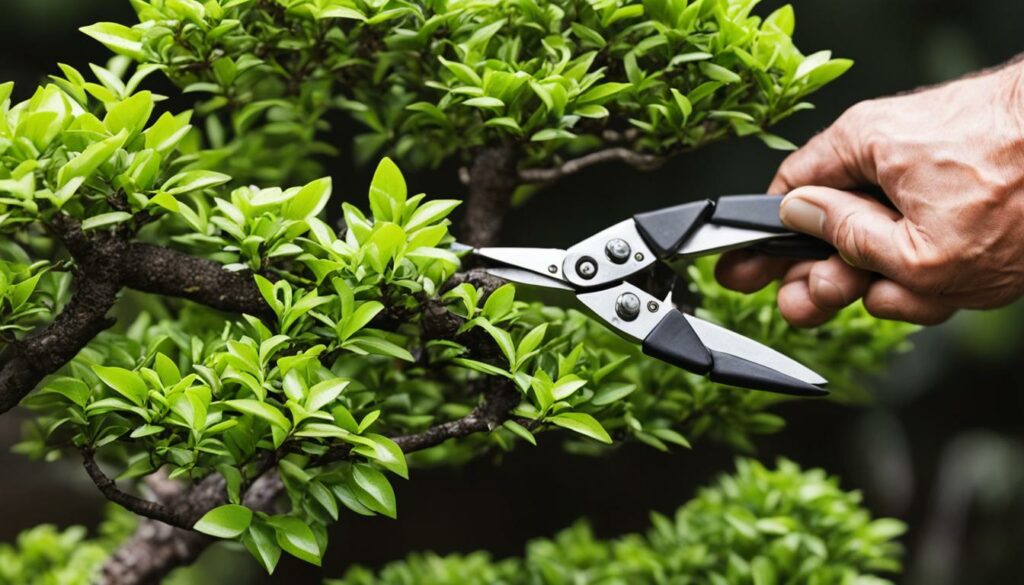
As a bonsai enthusiast, you may notice signs of ailing health such as leaf overcrowding, elongated branches, or an unbalanced shape. Here’s where strategic pruning steps in as a remedy, allowing you to carefully remove parts of the plant to prevent and solve structural issues. It encourages new growth, improves sun exposure and airflow, and maintains the miniature size of your bonsai, promoting a vibrant and healthy appearance.
- Selecting the right tools: Ensure you have a clean and sharp pair of bonsai scissors or shears.
- Identifying problem areas: Look for branches that disrupt the harmony of your bonsai’s design.
- Cleaning the canopy: Thinning the foliage for light penetration and tree health.
- Structural pruning: Removing large branches to enhance the tree’s overall shape.
- Maintenance trimming: Regular snips to keep the tree miniaturized and aesthetically pleasing.
Deploying these practices aids not just in aesthetics but also in the overall health and problem-solving aspect of bonsai care. The table below illustrates the types of pruning and their specific benefits:
| Type of Pruning | Benefits | Frequency |
|---|---|---|
| Pinching | Controls growth, refines smaller branches | As needed during growth seasons |
| Structural | Solves shape imbalances, prepares for training | Less frequent, as required for design |
| Maintenance | Encourages dense foliage, maintains size | Regularly, especially in active growing periods |
| Root Pruning | Encourages new root growth, keeps tree small | During repotting, typically every 2-3 years |
Remember that patience and observation are key to successful pruning. Each cut should be intentional and considerate of your bonsai’s unique form and needs. With these practices, you’ll not only solve existing issues but also foster a more resilient bonsai for the future.
Combatting Common Pests in Bonsai Trees
The serenity of caring for a bonsai tree can be quickly overshadowed by the discovery of unwelcome pests. Being proactive in your approach to bonsai pest management is vital. Staying vigilant for early signs can prevent extensive damage to these miniature landscapes. Understanding both preventative and reactive strategies ensures your bonsai remains healthy and vibrant.
Identifying Insect Infestations Early
The early detection of bonsai pests is a critical step in maintaining the integrity of your treasured plant. Regularly inspect your bonsai for common signs such as fine webbing, holes in the foliage, or a sticky residue on the leaves, which can indicate the presence of mites, beetles, or aphids. Swift identification leads to more effective pest control solutions for bonsai, safeguarding your plant’s longevity.
Natural and Chemical Pest Control Options
There are several avenues you can explore when it comes to eliminating pests from your bonsai. Natural solutions, such as introducing beneficial insects like ladybugs or applying neem oil, can be environmentally friendly and effective. However, for infestations that prove stubborn, chemical pesticides may be necessary. It is essential to use these products carefully, following instructions to prevent harming the tree’s delicate ecosystem.
Preventive Care Against Future Pest Issues
Preventive actions can significantly reduce the risk of future pest infestations in your bonsai. Ensuring proper watering, light, and nutrition helps to cultivate a robust plant capable of withstanding minor pest invasions without long-term harm. Regular cleanliness, such as removing dead leaves and debris, also plays a crucial role in keeping your bonsai pest-free.
Below is a table comparing common pests and suggested control strategies to help you maintain a healthy bonsai:
| Pest Type | Early Signs | Natural Solutions | Chemical Solutions |
|---|---|---|---|
| Spider Mites | Fine webbing on leaves | Neem oil, water spray | Miticides |
| Aphids | Sticky residue, distorted growth | Ladybugs, horticultural soap | Insecticidal sprays |
| Scale Insects | Bumps on stems and leaves | Manual removal, horticultural oil | Systemic pesticides |
By applying these measures and staying alert to the early warning signals, you’ll be better equipped to both tackle and prevent pest problems, ensuring that your bonsai thrives in its miniature world.
Recognizing and Treating Bonsai Diseases
As a bonsai enthusiast, it’s essential to recognize the early signs of disease that can threaten the health of your miniature tree. Bonsai disease identification starts with careful observation. Look out for discolored leaves, withered branches, or a general lack of vigor, which may indicate the presence of a harmful pathogen. Effective treatment for bonsai ailments hinges on timely detection, allowing you to take immediate action and prevent the spread of disease.
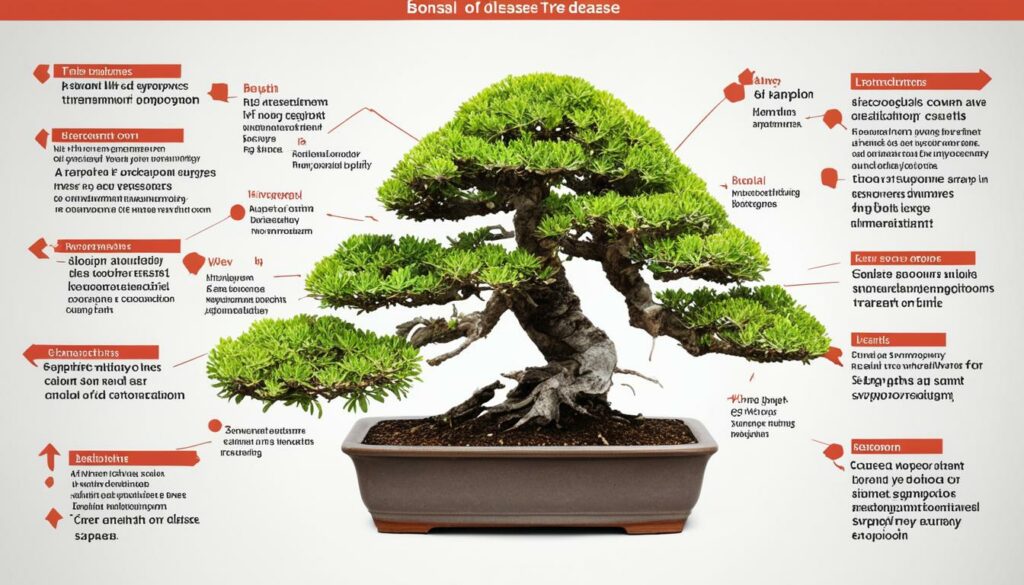
Let’s be proactive in protecting bonsai from diseases through a combination of quarantining infected plants, applying the appropriate fungicides or bactericides, and ensuring our bonsai have optimal growing conditions to stave off infection. For common diseases such as powdery mildew or root rot, consult the table below for symptoms and treatments:
| Disease | Signs of Infection | Recommended Treatment | Preventive Measures |
|---|---|---|---|
| Powdery Mildew | White, powdery spots on leaves and stems | Neem oil or sulfur-based fungicides | Improve air circulation; avoid overhead watering |
| Root Rot | Brown, mushy roots and yellowing leaves | Remove affected roots; treat with a fungicide | Ensure proper drainage; avoid overwatering |
| Leaf Spot | Brown or black spots with yellow halos on leaves | Prune affected foliage; apply copper-based treatments | Disinfect pruning tools; avoid wetting leaves when watering |
| Scale Insects | Brown or tan bumps on branches and underside of leaves | Insecticidal soap or horticultural oil sprays | Regularly inspect plants; introduce natural predators like ladybugs |
If you encounter a disease not listed or are unsure of the diagnosis, it’s wise to consult with a local bonsai expert or horticulturist. They can provide precise bonsai disease identification and tailor treatment strategies specifically for your tree’s condition. Remember, a healthy bonsai starts with prevention; consistent care and maintenance are key to protecting bonsai from diseases. With proper attention and swift action, you can help ensure that your bonsai remains a vibrant and inspiring part of your home or garden for years to come.
The Art of Bonsai Repotting: Timing and Techniques
Mastering the art of bonsai repotting is crucial for sustaining the health and growth of your cherished miniature trees. Bonsai repotting not only refreshes the soil and nutrients but also provides an opportunity to inspect and care for the roots. Selecting the optimal bonsai repotting schedule and repotting methods for bonsai can be the difference between a thriving specimen and one that struggles.
Determining When Your Bonsai Needs Repotting
Observing signs that it’s time for a repot is essential. Typically, this should occur when the roots have filled the pot, which may be every two to five years depending on the species and size of your bonsai. Slow growth, water pooling on the soil surface, or roots growing through drainage holes are indicators of a necessary repot. The best time is often during early spring as the tree exits dormancy and before the onset of vigorous growth.
Knowing when to repot your bonsai is to understand the rhythm of its life cycle and growth patterns.
Step-by-Step Guide to Repotting Your Bonsai
Repotting methods for bonsai demand precision and care. You must begin by preparing the new pot with adequate drainage layers and screening. Gently remove the bonsai from its current pot, carefully comb out the roots, and trim away any that are dead or overcrowded to maintain the tree’s health and encourage new growth. Secure your bonsai in its new pot with fresh bonsai-specific soil mix, ensuring proper placement and stability within the pot.
Caring for Bonsai Roots During Repotting
Bonsai root care during repotting is pivotal. Roots should be kept moist throughout the repotting process to avoid drying out. Trim them judiciously to encourage a compact root system that supports the small size of your bonsai; however, always refrain from over-pruning as this can shock the tree. After repotting, water thoroughly and keep your bonsai in a shaded area to recover without the stress of direct sunlight.
| Age of Bonsai | Repotting Frequency | Root Pruning | Soil Type |
|---|---|---|---|
| Juvenile | Every 1-2 years | Moderate to encourage growth | Nutrient-rich to foster development |
| Mature | Every 3-5 years | Minimal to maintain structure | Well-draining to prevent rot |
Now that you’re familiar with the fundamentals of bonsai repotting, you can confidently nurture your bonsai’s vibrant life beneath the soil—ensuring beauty and stability above.
Creating the Ideal Humidity and Temperature Conditions
To ensure your bonsai thrives, maintaining optimal humidity for bonsai and temperature within its environment is key. Unlike their outdoor counterparts, indoor bonsai trees don’t have the natural changes in humidity and temperature to signal their growth cycles. Therefore, crafting the right bonsai microclimate adjustments is a deliberate process that requires your attention and understanding.
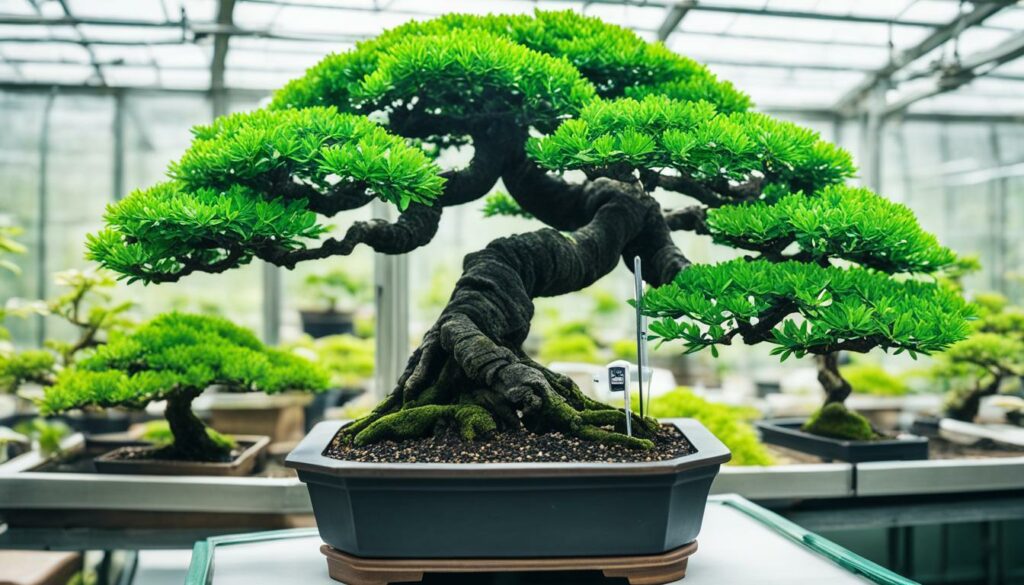
Creating a humid environment can be done using a humidity tray filled with water and pebbles, which will also catch excess water. This not only aids in bonsai temperature control by cooling the surrounding air but also provides a stable humid microclimate comparable to the bonsai’s natural habitat. Spraying your bonsai with a fine mist will further replicate the natural morning dew found in many native locations of bonsai trees.
- Humidity levels: Aim for a humidity level between 40-60% for your bonsai tree. A digital hygrometer can help you keep track of these levels efficiently.
- Seasonal changes: Be aware of the changing needs with seasons. In winter, you might need to provide a humidifier nearby to counteract the dry heat from indoors.
- Temperature fluctations: Keep the temperature steady, as rapid changes can stress your bonsai. A room where the temperature remains between 60-75°F (15-24°C) is ideal for most species.
Remember, rehabilitating a bonsai suffering from temperature or humidity stress is more difficult than maintaining a stable environment in the first place. Regularly monitor and adjust the humidity and temperature conditions according to your bonsai’s response. This will promote a healthier growth cycle and display the beauty of your bonsai to its full potential.
Mastering the Aesthetic: Overcoming Bonsai Styling Challenges
The art of bonsai shaping mastery is a delicate and thoughtful process, requiring patience and precision. To create a visually stunning bonsai that reflects both nature’s grandeur and the grower’s intent, understanding the nuances of styling and mastering specific techniques is vital.
Tools and Techniques for Shaping Your Bonsai
Having the right tools is as crucial as possessing the right skills when it comes to bonsai shaping. Precision shears, jin pliers, and knob cutters are just a few of the instruments designed to help you execute meticulous trims and adjustments. But beyond tools, mastering wire training for bonsai shaping is of paramount importance. It’s a craft that allows you to gently manipulate branches and trunks to achieve your desired design, guiding growth without causing damage to the plant.
Learning From Common Styling Mistakes
Even seasoned bonsai enthusiasts can fall prey to common bonsai styling errors. Recognizing these and learning to avoid them is essential for any cultivator. Over-pruning, neglecting to account for the tree’s growth patterns, and improper planting angles are frequent missteps that can hinder the aesthetic development of your bonsai.
Incorporating Wire Training into Your Routine
Wire training is an integral part of the bonsai styling sequence, but it’s often approached with trepidation. Using the appropriate gauge wire and carefully applying it along branches can train your bonsai to grow in the desired shape and direction over time. Removing the wire at the right moment is equally important to prevent scarring and to maintain the health of your bonsai.
| Tool | Function | Usage Tip |
|---|---|---|
| Concave Cutters | Creates smooth cuts to assist healing | Cut at an angle complementary to branch growth |
| Wire Cutters | For safely removing wires without damage | Always cut away from the bark to protect the plant |
| Bonsai Scissors | Precision trimming of leaves and small branches | Keep sharp for clean cuts that promote healing |
| Aluminum or Copper Wire | Guides the shaping of branches | Correct gauge allows for effective training without strain |
Guarding Bonsai Against Extreme Weather Conditions
When you’re cultivating the delicate art of bonsai, protecting bonsai from weather challenges can be a critical component of caring for these miniature trees. As a passionate bonsai enthusiast, understanding how to buffer your plants from severe heat, frost, and strong winds is essential. In this guide, we discuss the importance of bonsai care in extreme temperatures, and the vital steps in sheltering bonsai from harsh elements.
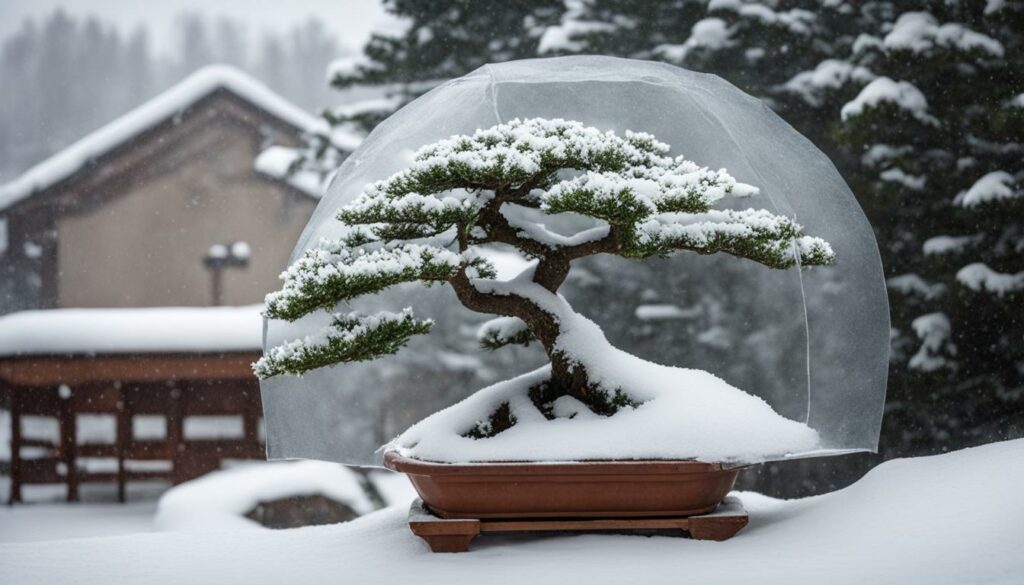
Bonsai, while robust in character, are inherently vulnerable due to their container-bound roots. Extreme weather events can result in heat stress, frostbite, dehydration, and physical damage. Here are practical tips and strategies to protect your bonsai:
- Summer Heat: Provide shade during the hottest parts of the day to prevent leaf scorch.
- Winter Cold: Move bonsai to a sheltered location, such as a cold frame or greenhouse, to protect from freezing temperatures.
- High Winds: Ensure bonsai pots are stable and, if necessary, relocate them to less exposed areas.
- Heavy Rainfall: Protect the soil from erosion and prevent waterlogging with proper drainage.
Creating a microclimate is an effective approach for managing the immediate environment of your bonsai. Consider the following weather protection plan for your bonsai, varying based on the current season:
| Season | Action | Benefit |
|---|---|---|
| Spring/Summer | Position in dappled sunlight, increase watering frequency | Reduces heat stress and maintains hydration |
| Autumn | Gradually reduce watering, mulch for insulation | Prepares tree for winter, conserves soil warmth |
| Winter | Shelter from snow/frost, water sparingly | Prevents root freeze and conserves energy |
“Your bonsai is not just a plant, it’s a living sculpture that requires patience, care, and respect, especially when the weather turns unfriendly. The effort put into protecting it from extremes will be reflected in its health and beauty.”
By being proactive and implementing these protective measures, you’ll not only ensure the survival of your bonsai but promote its thriving growth, whatever the weather may bring.
Choosing the Right Soil and Improving Drainage
For bonsai enthusiasts, the substrate in which your bonsai resides is the foundation of its health and longevity. The quest for the ideal bonsai soil selection is critical, as it must cater to the unique water, nutrient, and aeration needs of your miniature tree. In tandem with enhancing bonsai soil drainage, you are setting up your bonsai for success. Let’s delve into understanding soil types and their properties, learn to tackle drainage issues effectively, and explore creating custom bonsai soil mixtures that will promote vigorous, healthy growth.
Understanding Soil Types and Their Properties
Every bonsai species comes with its individual soil requirements. Soils range from sandy to clay-heavy compositions, and each type has distinct attributes. Aeration and water retention are key factors to consider when choosing soil for your bonsai to thrive. Porous materials like Akadama, Pumice, and Lava Rock often feature in bonsai soil mixtures due to their excellent drainage capabilities yet sufficient moisture retention.
Fixing Poor Drainage to Prevent Root Rot
Root rot can spell disaster for a bonsai, and it often stems from inadequate drainage. To improve the drainage of your bonsai soil, incorporate non-compact materials that create air pockets and allow water to flow freely. Monitoring your bonsai after watering is crucial; water should exit the drainage holes quickly, indicating that the soil is properly aerated and drainage is effective.
DIY Soil Mixes for Healthy Bonsai Growth
Crafting your custom bonsai soil mixtures allows you to address the particular needs of your bonsai. Common components include Akadama for structure, Pumice for moisture management, and organic matter like pine bark for nutrient retention. Tailoring these elements to suit your bonsai can significantly improve its health and vitality.
- Akadama: A clay-like material that provides structure and moisture retention.
- Pumice: A volcanic byproduct that helps with aeration and drainage.
- Lava Rock: Adds to the soil’s porousness, further enhancing drainage.
- Organic Composts: Provide long-term nutrients and can retain a degree of moisture.
By optimizing bonsai soil selection and addressing drainage, you can create an environment where your bonsai not only survives but also thrives. Remember, the perfect soil mix is about balance — allowing for proper drainage and retention of just the right amount of water and nutrients. To truly master this art, ongoing experimentation and observation of your bonsai’s response will guide you towards the ideal mixture for your miniaturized tree.
Customizing Care for Different Bonsai Species
Understanding the nuanced requirements of your bonsai is a critical component of successful cultivation. Recognizing that species-specific bonsai care is paramount can mean the difference between a thriving bonsai and one that struggles. In this section, we’ll explore the tailored care that different species demand and the considerations to keep in mind for both indoor versus outdoor bonsai maintenance.
Identifying Unique Needs of Popular Bonsai Types
Each bonsai species presents a unique set of cultural needs. For example, the delicate leaves of a Ficus bonsai may require different light conditions compared to the rugged, sun-loving nature of a Juniper bonsai. Acknowledging these specialized care requirements for diverse bonsai types is essential to nurture and enhance your bonsai’s health and aesthetic appeal.
Adapting Care Practices for Indoor vs. Outdoor Bonsai
Indoor bonsai species like the Chinese Elm or Schefflera benefit from stable temperatures and controlled exposure to sunlight, while outdoor species such as Pine or Maple bonsai embrace the changing seasons and natural elements. Adapting your care regimen with respect to the bonsai’s placement, be it indoors or outdoors, ensures that your tree receives the right balance of light, water, and air circulation.
Tips for Tropical and Coniferous Bonsai Care
Tropical bonsai trees often require a moist, warmer environment, making humidity control an important factor, especially indoors. On the other hand, coniferous bonsai trees, which are mostly kept outdoors, need protection from extreme temperatures and winds. No matter the species, each bonsai will showcase its best form and vitality when given the care it specifically demands.
Leveraging Expertise: Where to Find Bonsai Wisdom
Embarking on the bonsai journey demands more than just a green thumb; it requires dedicated pursuit of gaining knowledge in bonsai care. With the right bonsai community resources and expert bonsai advice, you can refine your skills and deepen your understanding of this ancient art form. Below, discover how to connect with the wisdom of the bonsai world.
Begin by joining local bonsai clubs. These gatherings are a treasure trove of knowledge, offering everything from hands-on workshops to insightful demonstrations. You can develop your techniques under the guidance of experienced practitioners who have nurtured their bonsai for decades.
Forums and online platforms are a click away for engaging with fellow enthusiasts. These digital communities buzz with discussions ranging from basic care to advanced styling tips, and are frequented by novices and pros alike. You’ll find an abundance of shared experiences and a chance to ask detailed questions.
Subscription to specialty bonsai magazines and browsing through an extensive range of literature on bonsai care can also enrich your understanding. Experts often put pen to paper, revealing their personal experiences and successful care strategies.
Participating in workshops led by revered professionals offers a hands-on approach to mastering bonsai. These sessions often focus on specific topics, providing intensive learning experiences and personalized feedback.
- Local Bonsai Clubs – Network and learn from seasoned growers.
- Online Forums – Ask questions and share experiences with an international community.
- Literature and Magazines – Dive into written expertise and time-tested advice.
- Professional Workshops – Gain practical skills from established experts.
Your journey with bonsai is perpetual. As you continuously engage with these resources, you will find that your knowledge, techniques, and passion for bonsai grow alongside your trees.
| Resource | Benefits | How to Access |
|---|---|---|
| Local Bonsai Clubs | Face-to-face interaction, hands-on learning, regional specific advice. | Search online for clubs in your area or visit your local botanical garden. |
| Online Bonsai Forums | Wide range of topics, global perspectives, accessible any time. | Join platforms like Bonsai Nut or Internet Bonsai Club. |
| Bonsai Literature | In-depth exploration of topics, techniques, and species. | Purchase books or subscribe to magazines like Bonsai Focus or Kinbon. |
| Professional Workshops | Concentrated learning, immediate feedback from experts, skills refinement. | Enroll in workshops offered by bonsai nurseries or during exhibitions. |
Remember, every bonsai artist was once a beginner. By immersing yourself in the rich tapestry of bonsai community resources, you are continuing the legacy of this living art. Seek out expert bonsai advice, and nurture your bonsai with the wisdom of the masters before you.
Conclusion
As we reach the end of this guide, we trust that the insights provided will serve as a compass for navigating the intricate process of bonsai care. A recapitulation of key troubleshooting tips across each phase of the bonsai’s life cycle offers you a foundation to ensure your miniature trees remain vigorous and visually striking. Whether you faced challenges with watering, sunlight, pests, or diseases, the solutions offered aim to equip you with the knowledge to address issues promptly and effectively.
Recap of Key Troubleshooting Tips for Bonsai Health
Summarizing bonsai problem-solving, it is evident that understanding your bonsai’s unique requirements is pivotal to its health. From the nuances of watering to the finesse of pruning, each tip provided has been carefully curated to help you pinpoint and remedy any signs of distress. Remember, a healthy bonsai is a balance of the right environment, vigilant care, and timely intervention.
Encouragement for Continued Learning and Patience
Bonsai cultivation is as much an art as it is a science. Promoting ongoing bonsai education, we encourage you to immerse yourself in the ever-evolving learning curve that is the essence of bonsai mastery. Patience and dedication are virtues that will see your bonsai through the most challenging periods, transforming obstacles into opportunities for growth—both for the tree and for you as a cultivator.
Next Steps in Your Bonsai Journey
Armed with the knowledge shared, you stand on the threshold of the next phases in bonsai cultivation. Forge ahead with confidence, integrating new techniques into your care regimen and engaging with the bonsai community for deeper insights. Your journey is unique, and as your bonsai flourishes, so will your expertise, bringing fulfillment and tranquility to your garden, one bonsai at a time.
FAQ
What are the common signs that my bonsai is unhealthy?
Common signs of bonsai distress include yellowing leaves, stunted growth, loss of leaves, wilted foliage, and visible issues on the bark or trunk. Timely identification and addressing the underlying cause are essential for plant recovery.
How can I determine the unique needs of my specific bonsai species?
To care for your bonsai properly, you need to understand its species-specific requirements, such as preferred sunlight levels, watering frequency, and optimal temperature range. Research your bonsai’s species or consult a bonsai expert for tailored guidance.
What are the correct watering techniques for bonsai trees?
Proper bonsai watering involves checking the moisture level of the soil and watering thoroughly when the top layer begins to dry. This typically means deep watering until excess water runs out of the drainage holes. Avoiding overwatering and underwatering is crucial for bonsai health.
How do I ensure my bonsai receives adequate sunlight?
Place your bonsai in a location where it will receive the right amount of light for its species—usually a spot with bright, indirect sunlight. Be cautious of too much direct sun, which can burn the leaves and stress the plant.
What should I do if I suspect my bonsai is overfertilized?
If you notice signs of overfertilization, such as burned leaf edges or a white crust on the soil surface, flush the soil with plenty of water to dilute excess fertilizer. Adjust your fertilization schedule and amount moving forward to prevent recurrence.
When and how should I prune my bonsai tree?
Prune your bonsai during the tree’s appropriate growth season, which varies by species. Use sharp, clean tools to make precise cuts. Pruning helps to shape the tree, encourage new growth, and remove any dead or diseased branches.
What are some effective pest control solutions for my bonsai?
Identify the pest type and choose a treatment method—natural solutions like neem oil or insecticidal soap may work for minor infestations, while more severe cases might require chemical pesticides. Always follow product instructions and treat pests early to minimize damage.
How can I recognize and treat diseases in my bonsai?
Look for symptoms such as unusual leaf spots, mold, or decay. Isolate the affected bonsai to prevent spread and apply appropriate fungicides or bactericides. Consult a bonsai expert if you’re unsure of the disease or treatment.
What is involved in repotting a bonsai tree?
Repotting involves carefully removing the bonsai from its existing pot, pruning the roots if necessary, and placing it in fresh soil within a suitable pot. This should be done every few years to prevent root-bound conditions and replenish nutrients in the soil.
How do I protect my bonsai from extreme weather conditions?
Provide shelter during acute weather events, use shade screens to protect from intense sunlight, and move your bonsai indoors or to a more sheltered spot during harsh winters. Consider the specific requirements and tolerance of your bonsai species when protecting it from weather extremes.
Which soil type is best for my bonsai, and how do I improve drainage?
Bonsai typically thrive in well-draining soil that retains moisture without waterlogging. You may need to customize your soil mix to achieve the right balance. To improve drainage, add coarse materials like pumice, akadama, or lava rock to your soil mix.
How can I adapt my bonsai care practices for an indoor vs. outdoor setting?
Indoor bonsai require attention to ensure enough light and humidity, so place them near a bright window and use a humidity tray. Outdoor bonsai should be protected from extreme temperatures and excessive elements. Adapt watering and feeding to correspond with the environment.
Where can I find expert advice and community support for bonsai care?
Seek out local bonsai clubs, online forums, and social media groups dedicated to bonsai care. These communities are valuable for connecting with experienced bonsai enthusiasts, attending workshops, and accessing a wealth of knowledge and tips.
